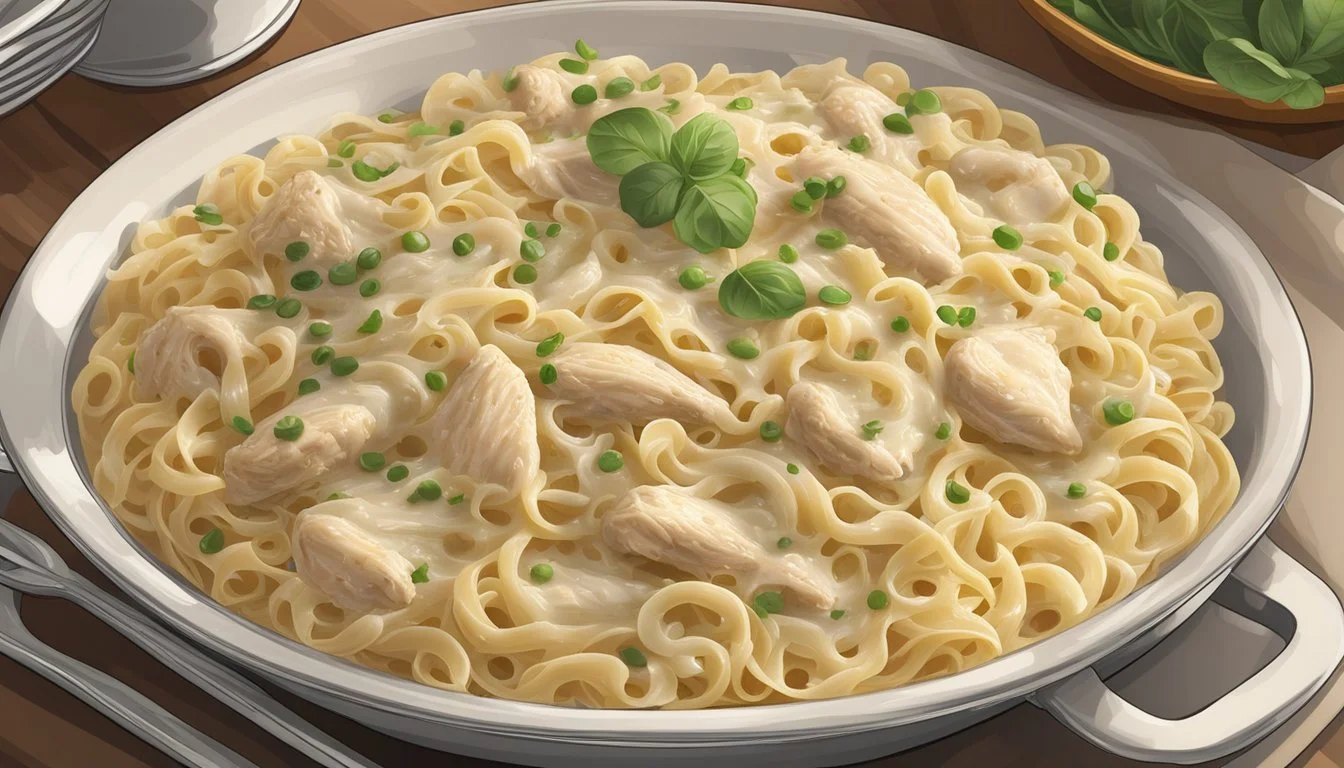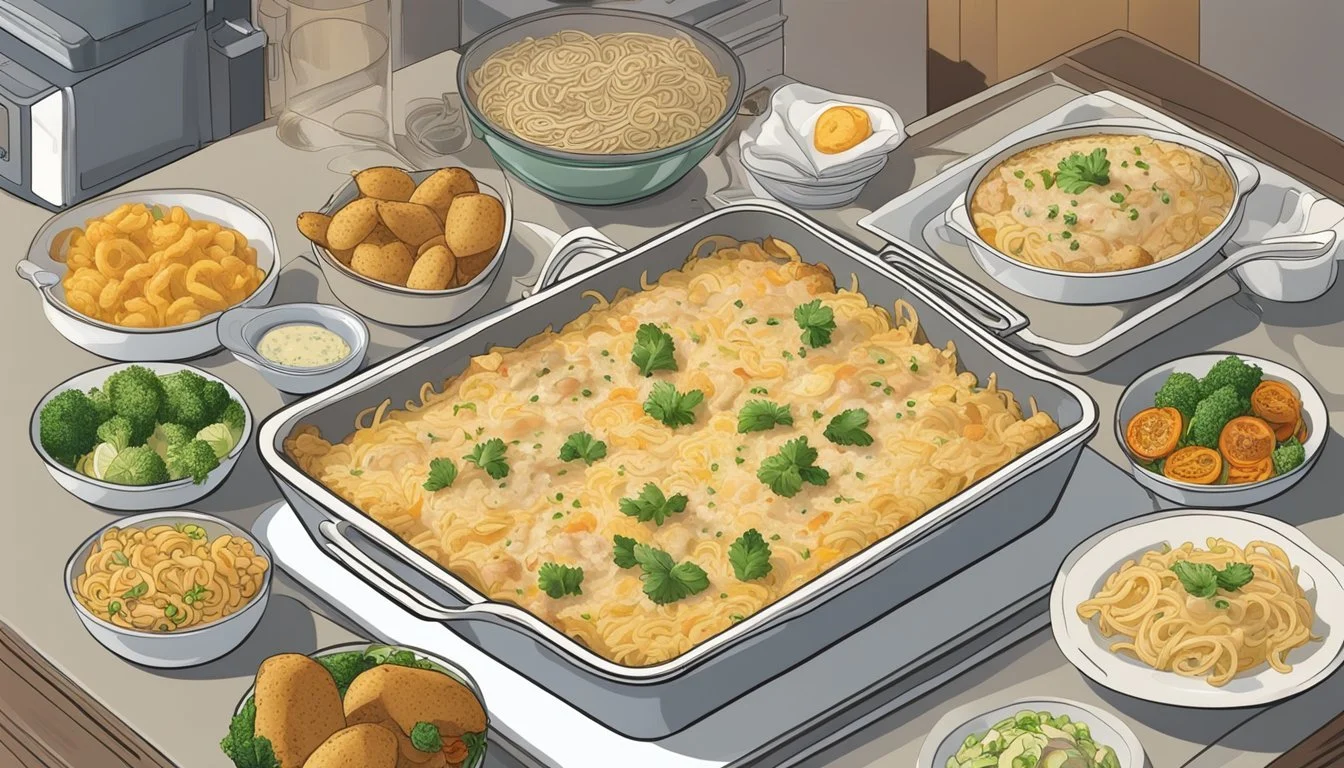Best Way to Reheat Chicken Tetrazzini
Keeping Sauce Intact
Reheating Chicken Tetrazzini can be challenging, with the potential for the creamy sauce to separate or the pasta to become overcooked. To maintain the dish's texture and flavor, careful reheating is essential. One concern when reheating creamy pasta dishes like Chicken Tetrazzini is the tendency for the sauce to lose its emulsion, becoming oily or grainy rather than remaining smooth and cohesive. Ensuring the dish reaches a safe internal temperature of 165°F without compromising its quality requires a method that gently warms the Tetrazzini while preserving the integrity of its sauce.
The oven is often the preferred appliance for reheating dishes such as Chicken Tetrazzini. When using the oven, covering the dish with aluminum foil can prevent the top from drying out or burning while the rest of the Tetrazzini heats through. The foil also helps to retain moisture, which is beneficial for keeping the sauce creamy. After the dish is heated thoroughly, a brief period of baking uncovered can lend a desirable crispness to the top layer, enhancing the dish's texture and adding a slight contrast to the creamy pasta and chicken below.
Understanding Chicken Tetrazzini
Chicken Tetrazzini is a creamy, cheese-laden pasta dish that often includes mushrooms and chicken. Proper reheating is crucial to maintain its texture and flavor.
Components of Chicken Tetrazzini
Chicken Tetrazzini typically involves the following core ingredients:
Pasta: Spaghetti is commonly used, cooked until it's al dente.
Chicken: Cooked and diced or shredded chicken breast is preferred for its tender texture.
Mushrooms: Often sautéed and combined with the pasta and chicken for an earthy flavor.
Sauces and Cheese: A rich sauce, sometimes including cream of mushroom, along with a mixture of cheeses, usually Parmesan, binds the dish together.
Breading: Panko breadcrumbs may be sprinkled on top before baking to add a crunchy texture.
Ingredients such as cream, butter, and cheese are crucial for the creamy consistency of the dish. They must be carefully balanced to prevent the sauce from separating during the reheating process.
Why Proper Reheating Matters
Correctly reheating Chicken Tetrazzini ensures that the dish's different components—the tender chicken, the perfectly cooked pasta, and the savory, creamy sauce—stay integrated, retaining their individual textures and flavors without turning the dish into a separated or oily mess. Reheating should be done gently and evenly. This often involves covering the dish with foil to prevent moisture loss and baking at a moderate temperature, typically around 350°F (175°C), until it reaches a food-safe temperature of 165°F. Heating it uncovered at a higher temperature for a brief period can help crisp up the top layer, bringing back some of the textured contrast that makes a freshly baked Chicken Tetrazzini so appealing.
Preparing for Reheating
Proper storage and thawing are the linchpins in ensuring the Chicken Tetrazzini retains its quality during reheating. They should follow food safety guidelines to prevent spoilage and maintain flavor.
Storing Chicken Tetrazzini
Leftovers should be stored in the fridge or freezer promptly to preserve freshness and prevent bacterial growth. For refrigeration, place the Chicken Tetrazzini in an airtight container and store it for up to three to four days. To freeze, transfer it to a freezer-safe container or wrap it tightly with aluminum foil or freezer wrap. Frozen Tetrazzini will maintain optimal quality for two to six months but remains safe beyond that time frame.
Thawing Frozen Tetrazzini
When ready to reheat, if the Tetrazzini is frozen, it's crucial to defrost it properly to ensure even reheating. To thaw, one should transfer the dish from the freezer to the fridge and allow it to defrost slowly, typically overnight. A slow thaw ensures the temperature never reaches a point where harmful bacteria can thrive, aligning with food safety standards. Avoid thawing at room temperature as it can cause the edges to warm and spoil before the center has defrosted.
Reheating Methods
Reheating Chicken Tetrazzini requires a method that maintains the integrity of its creamy sauce and pasta while ensuring the dish is heated evenly. Here are the most effective techniques to warm up this classic dish without separating the sauce.
Oven Reheating for Optimal Results
Oven Method: Reheat the Chicken Tetrazzini in its original casserole or a similar oven-proof baking dish, which allows for even heat distribution. The oven should be preheated to 350°F. Cover the casserole with aluminum foil to prevent the top from browning too quickly and to retain moisture. Heat the Chicken Tetrazzini for about 20-30 minutes, or until the internal temperature reaches 165°F.
Steps:
Preheat oven to 350°F.
Place Chicken Tetrazzini in an oven-proof dish.
Cover with foil.
Bake until an internal temperature of 165°F is reached.
Microwave for Quick Reheating
Microwave Method: The microwave offers a quick reheating option. To reheat Chicken Tetrazzini in the microwave, place a single serving in a microwave-safe dish. Cover it with a damp paper towel to encourage steam, which helps evenly distribute heat and maintain the sauce consistency. Set the microwave to a medium power setting and heat in 1-minute intervals, stirring in between until thoroughly warmed.
Instructions:
Place a serving of Chicken Tetrazzini in a microwave-safe dish.
Cover with a damp paper towel.
Use a medium power setting.
Heat in 1-minute intervals, stirring between each.
Stovetop Reheating Techniques
Stovetop Method: For stovetop reheating, transfer the Chicken Tetrazzini into a skillet or a pot suitable for the amount being reheated. Add a splash of milk or broth in order to revitalize the sauce and prevent it from drying out. Heat over medium heat, stirring frequently until the dish is evenly heated and reaches the safe temperature.
Guidelines:
Transfer Chicken Tetrazzini to a skillet or pot.
Add a small amount of milk or broth.
Heat over medium, stirring frequently.
Ensure even heating to 165°F before serving.
Maintaining Creamy Sauce Consistency
When reheating Chicken Tetrazzini, it's imperative to preserve the integrity of the creamy sauce. Attention to temperature control and moisture levels is crucial.
Preventing Sauce Separation
Temperature: Gradual reheating prevents the sauce from breaking. Begin with a moderate oven temperature of 350°F.
Technique: Stirring the sauce occasionally during the reheating process promotes even heat distribution.
Restoring Moisture and Creaminess
Cream or Milk Addition: If the sauce still appears too thick, one can gently stir in a small amount of cream or milk. This reintroduces moisture, helping to maintain a silky texture.
Chicken Broth: For a lighter option, a spoonful of chicken broth can add back some of the lost moisture without weighing down the sauce.
Incorporating these methods ensures the Tetrazzini's sauce retains its allure, serving a dish as delightful as when first prepared.
Final Touches and Side Dishes
When reheating chicken tetrazzini, it's crucial to maintain its creamy texture and robust flavor. Serving it with complementary side dishes elevates the meal and balances the palate.
Enhancing Flavor After Reheating
Seasoning: A key step after reheating chicken tetrazzini is to check the seasoning. Tastefully adding sea salt and freshly ground black pepper can revitalize the dish. One may consider a dash of garlic powder or finely chopped onion to enliven the sauce without overwhelming it.
Herbs: Parsley is a simple, yet effective herb for adding a fresh element. It should be finely chopped and sprinkled on top to bring a bright contrast to the rich, creamy sauce.
Olive Oil: Sometimes, a light drizzle of high-quality olive oil on the reheated tetrazzini can provide a subtle, fruity undertone, enhancing the overall mouthfeel.
When serving chicken tetrazzini, which by itself is a comfort food, it pairs nicely with a variety of side dishes:
Bread: Fresh, crusty bread or garlic knots serve as an excellent vehicle for sopping up the creamy sauce.
Salad: A crisp green salad dressed with a simple vinaigrette offers a refreshing counterpoint to the dish. Opt for a Caesar salad or a colorful mix of rainbow roasted vegetables.
By making subtle adjustments to the seasoning and selecting the right side dishes, one can create a harmonious meal that celebrates the homey goodness of chicken tetrazzini.
Food Safety and Best Practices
When reheating chicken tetrazzini, maintaining the integrity of the sauce and ensuring the safety of the dish are essential. Correct reheating techniques prevent bacterial growth and preserve the quality of the meal.
Ensuring Proper Internal Temperature
For food safety, reheating cooked chicken to the right internal temperature is crucial to eliminate any potential bacteria. The USDA recommends that one should reheat leftovers to an internal temperature of 165°F. Here's a step-by-step guide to safely reheating chicken tetrazzini:
Preheat the oven to 350°F.
Transfer leftover chicken tetrazzini to an oven-safe dish if it's not in one already.
Cover the dish with aluminum foil to prevent the top from drying out and to ensure even heat distribution.
Place the dish in the oven.
Heat the tetrazzini until it reaches an internal temperature of 165°F. This usually takes about 20-30 minutes.
The internal temperature can be checked using a food thermometer, which should be inserted into the thickest part of the dish.
By following these steps, one will not only comply with food safety standards but also enjoy their leftover chicken tetrazzini as if it were fresh.
Special Considerations
When reheating Chicken Tetrazzini, one must ensure that the dish's integrity and flavor are maintained, especially for those with dietary restrictions. The choice of reheating appliance can also impact the dish's quality and nutritional aspects.
Adjustments for Dietary Restrictions
For gluten-free diets, one must ensure that the pasta used in the Chicken Tetrazzini is gluten-free. When reheating, it's also essential to prevent cross-contamination with gluten-containing foods which could affect those with celiac disease or gluten sensitivity.
Lower Sodium: To reduce sodium intake, one should:
Use low-sodium broth when initially preparing the dish.
Refrain from adding extra salt during the reheating process.
Calorie Considerations: To manage calorie content:
Opt for low-fat dairy products.
Measure portion sizes carefully to maintain control over caloric intake.
Alternative Reheating Appliances
Microwave: For a quick method, use a microwave-safe dish, cover with a microwave-safe lid, and reheat in short bursts, stirring in between to maintain an even temperature and prevent sauce separation.
Oven: Preheat the oven to 350°F, cover the Tetrazzini with foil to retain moisture, and heat until the internal temperature reaches 165°F.
Air Fryer: An air fryer can be used, but it may not evenly reheat larger portions. To prevent sauce separation:
Set it to a low temperature (about 300°F).
Use an air fryer-safe container and cover the Tetrazzini, reheating for 10-15 minutes.




